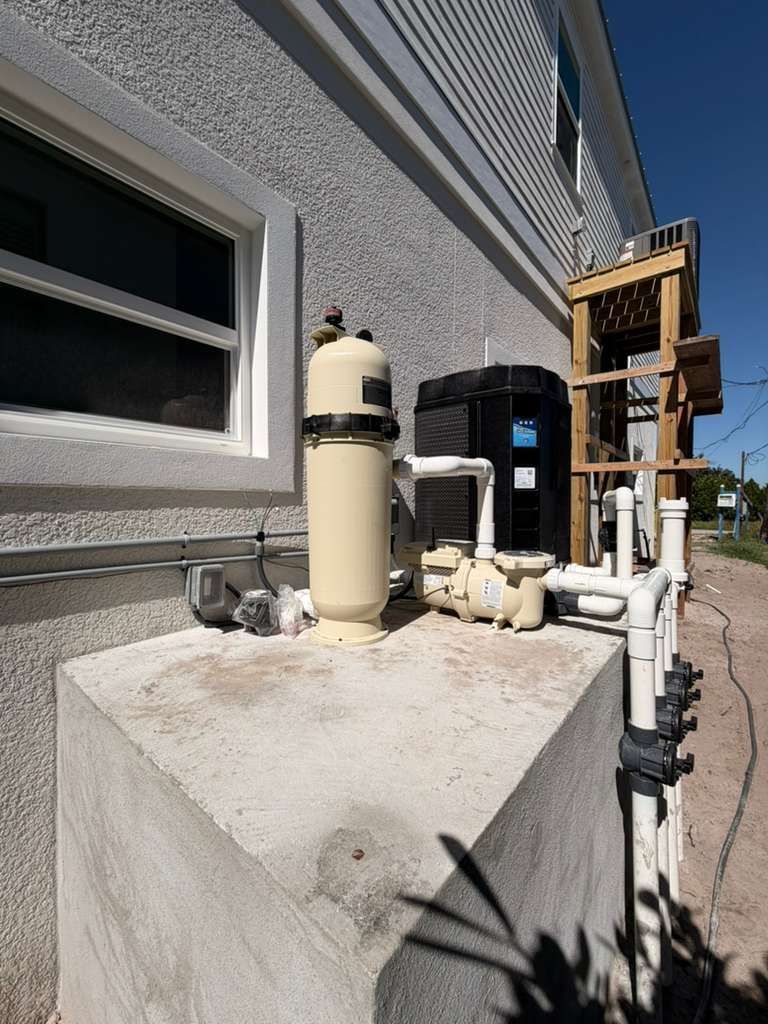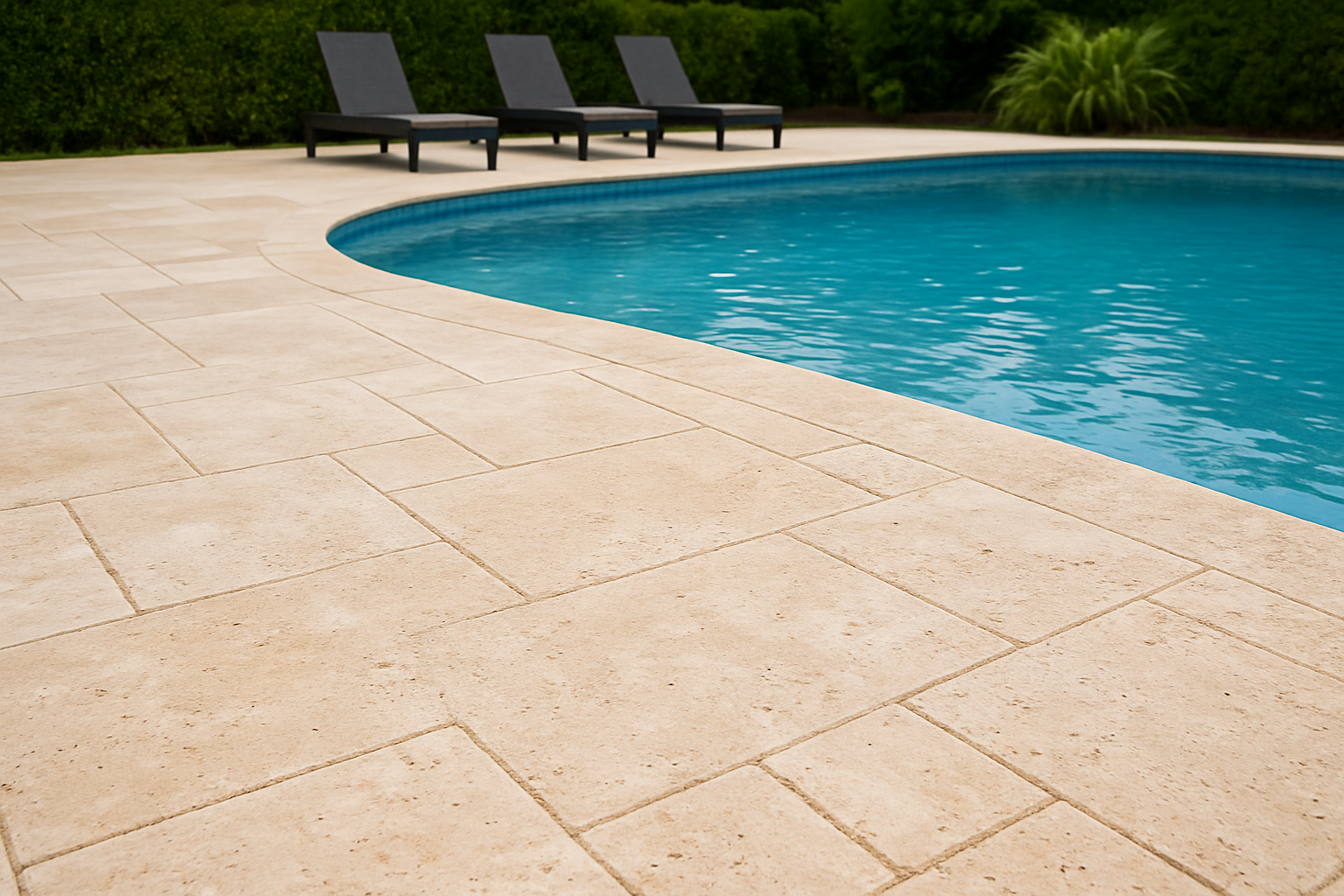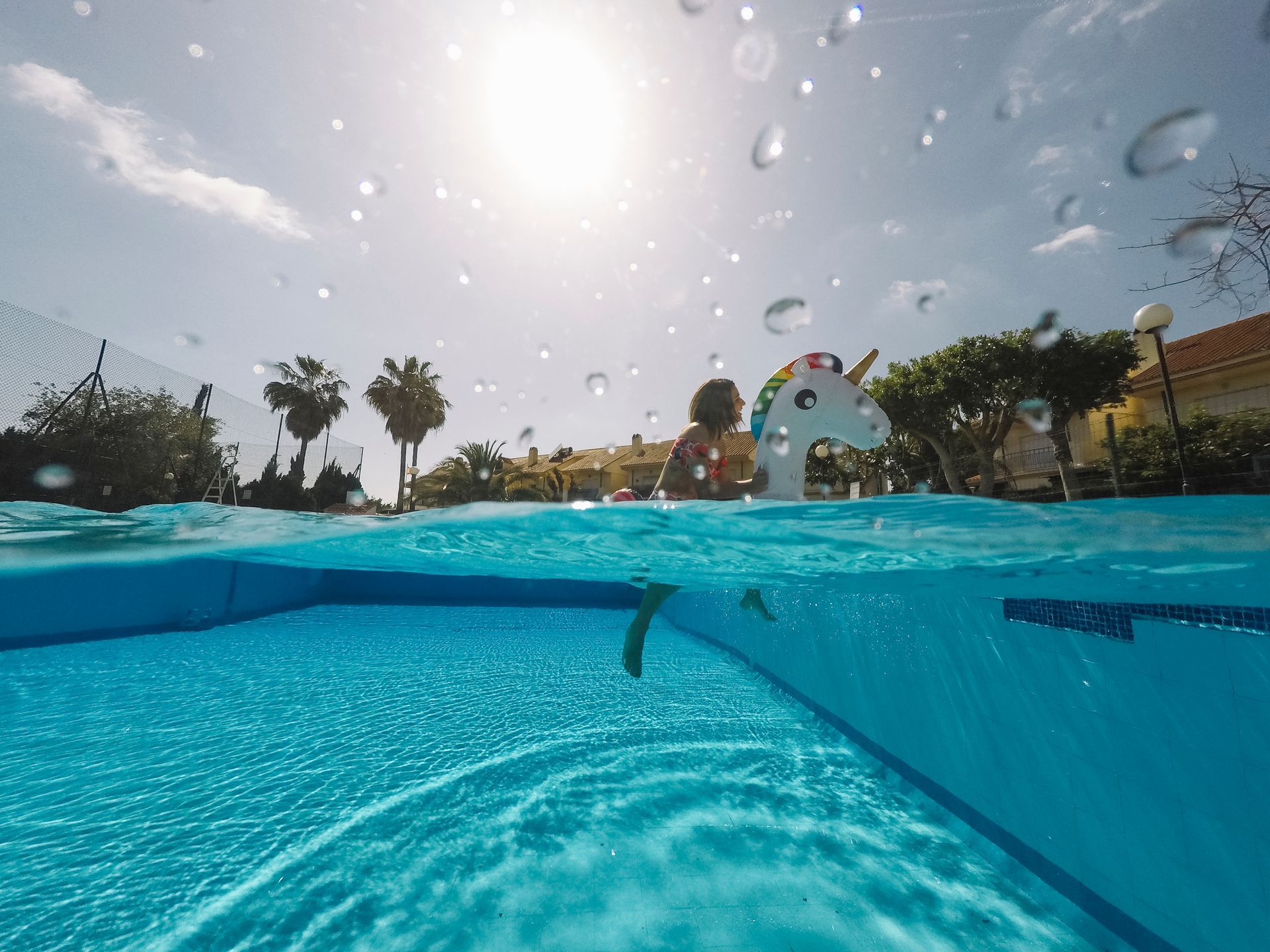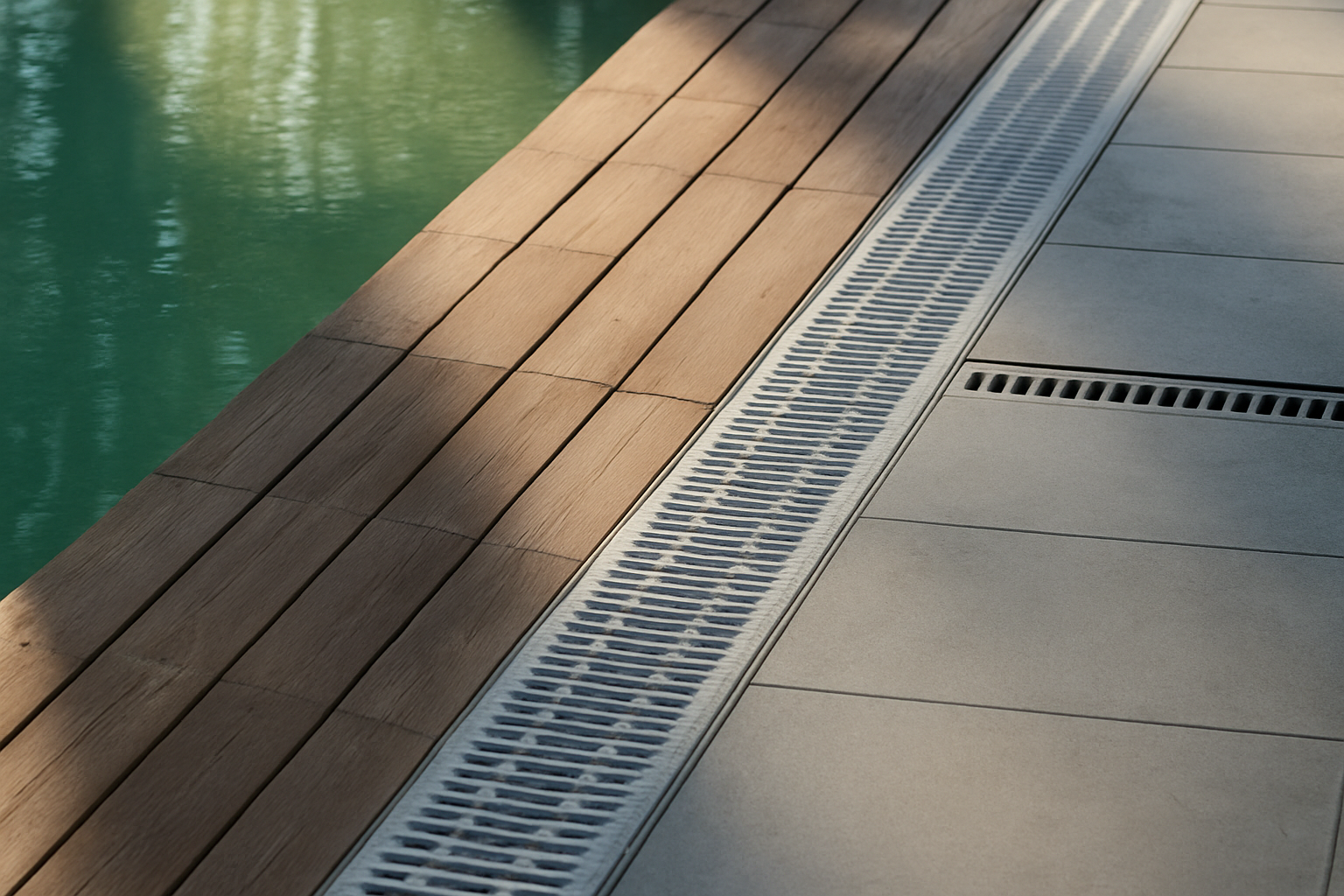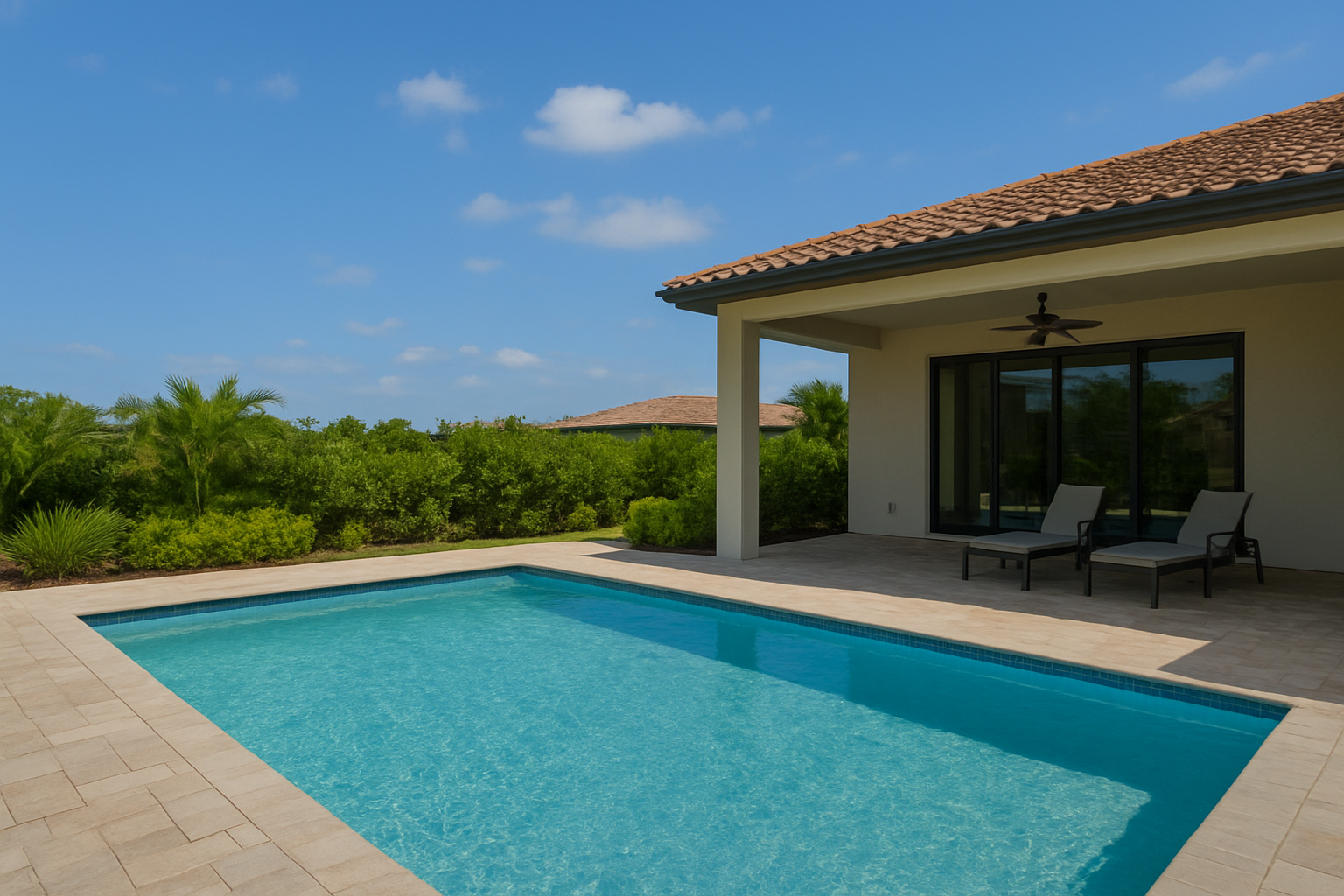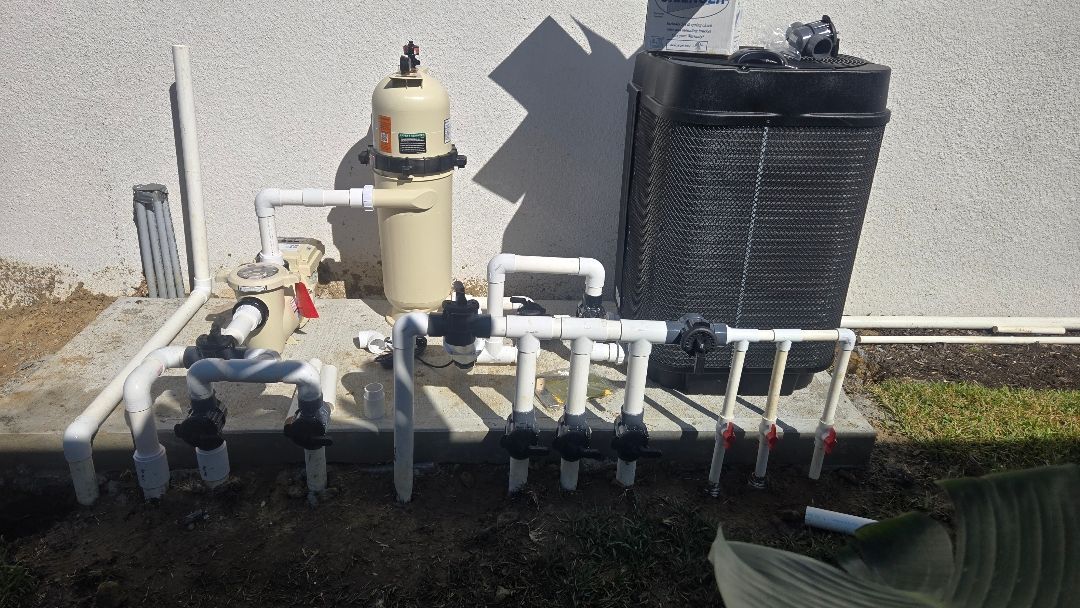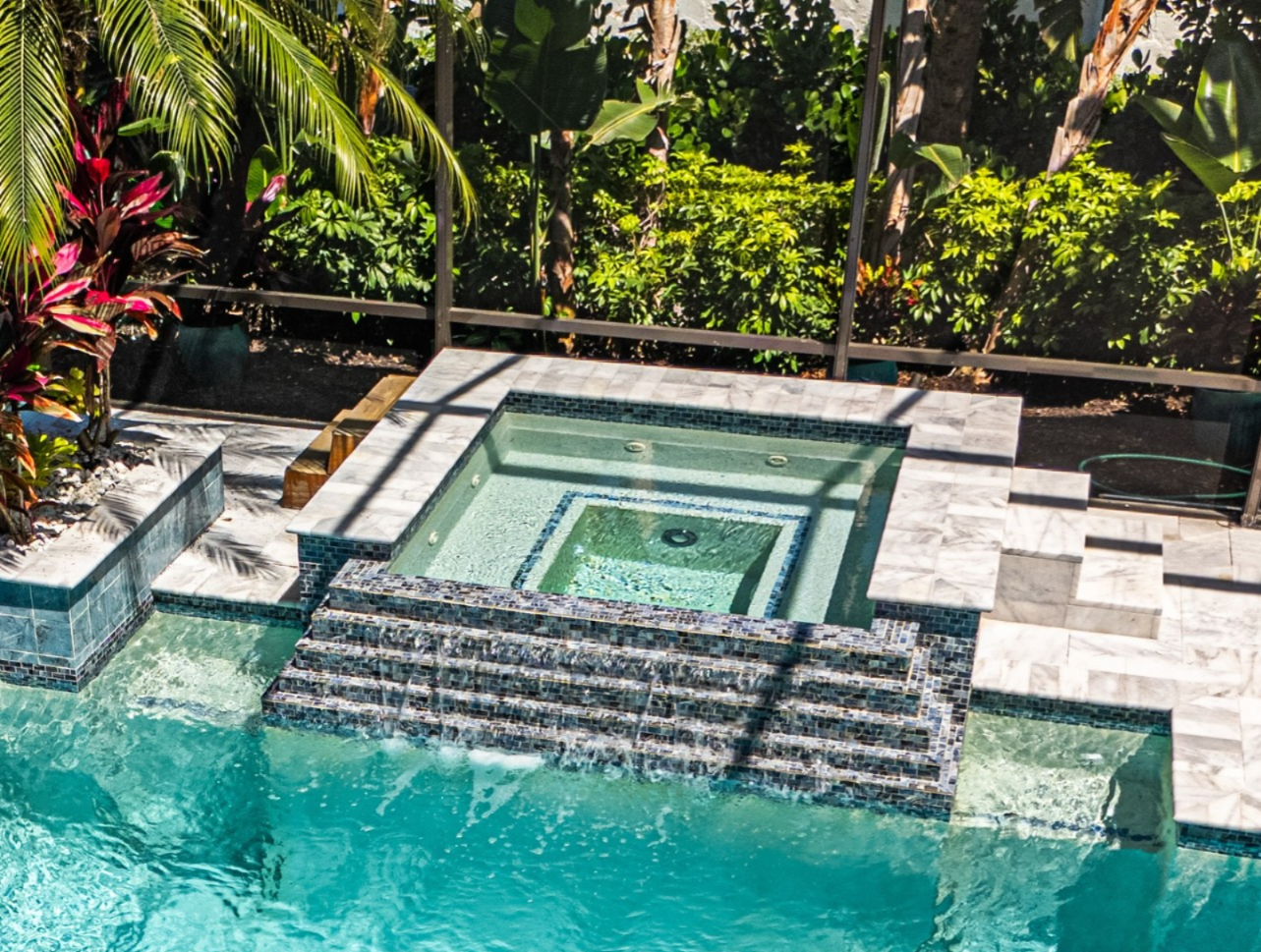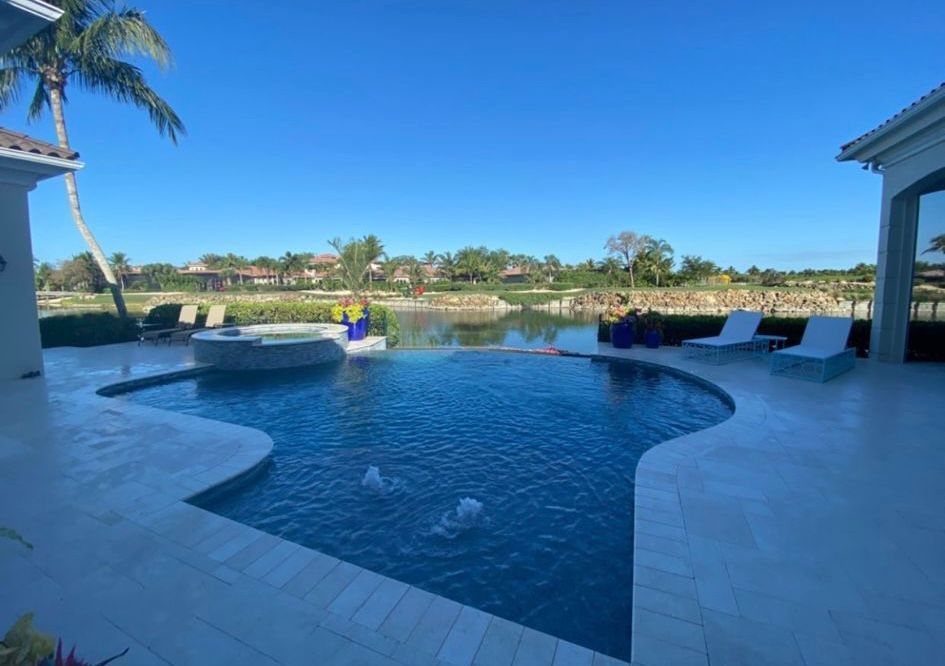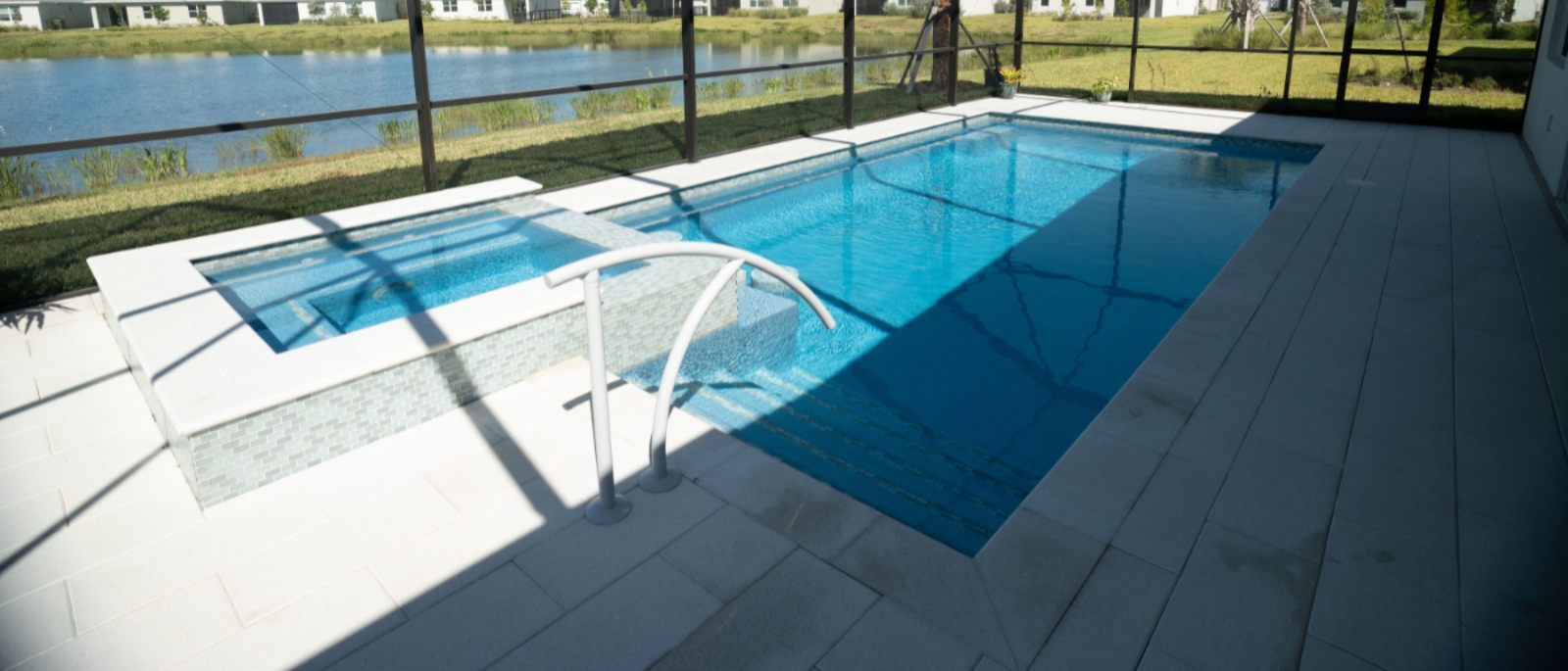EASY STEPS TO KEEP YOUR POOL CRYSTAL CLEAR
Keeping your pool in tip-top shape isn't just about having a pretty backdrop for your Instagram photos. Regular pool maintenance is the secret for a safe and long-lasting swimming experience. By staying on top of your pool maintenance, you're ensuring that your pool is always ready for a refreshing swim.
Picture this: you arrive at your backyard on a hot summer afternoon. The sun glints off water so-clear you can see the bottom tile design shimmering — inviting, refreshing. Now flip the scene: cloudy water, green tinge, a smell you wish you could ignore, skim basket overflowing. Which pool are you stepping into?
Over 80% of pool damage and costly repairs stem from neglecting basic maintenance. Small problems like unbalanced water chemistry or clogged filters don’t just ruin your swim—they can lead to serious issues that cost thousands.
We’ll take you through easy, practical steps to keep your pool crystal clear — so it always looks like that first perfect scene.
- A clean pool is a safe pool. Regular maintenance helps prevent the growth of harmful bacteria and algae that can pose health risks.
- There's nothing like clear water. Proper maintenance keeps your pool looking inviting.
- Regular care helps prevent unnecessary wear and tear, saving you money on repairs and replacements in the long run.
- Maintaining the right chemical balance prevents skin and eye irritation for swimmers.
- A clean pool with well-maintained equipment runs more efficiently, potentially lowering your energy bills.
- A well-kept pool is attractive for potential buyers if you ever decide to sell your house.
Daily Pool Maintenance Tasks
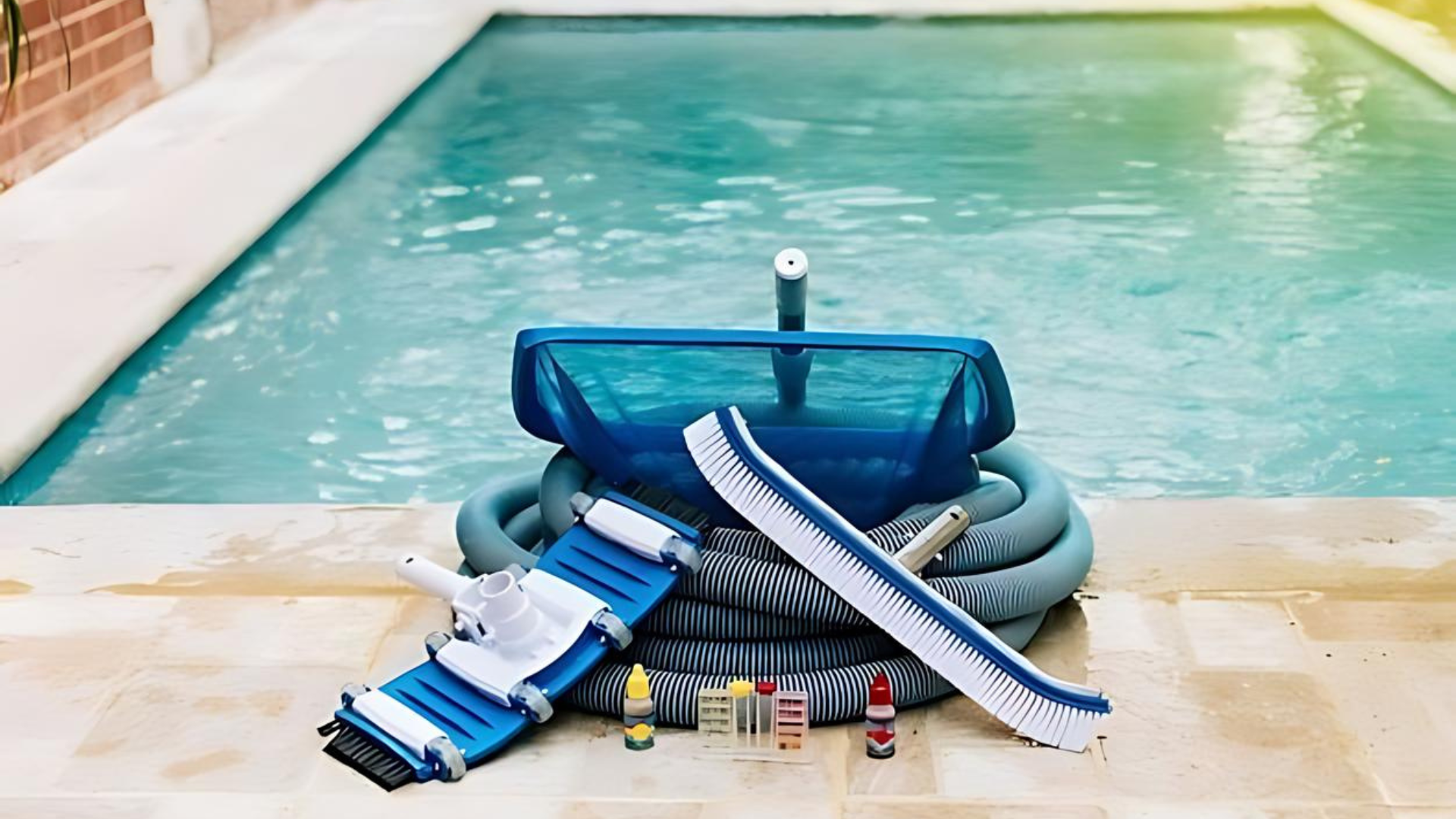
Keeping your pool in good conditions doesn't have to be a full-time job. By incorporating some quick and easy daily tasks into your routine, you will keep your pool in optimal condition.
Daily Tasks:
Skimming the Surface
Take a few minutes each day to skim the water's surface, removing leaves, insects, and other floating debris. This simple task also prevents this material from sinking and potentially clogging your filter system.
Our recommendation: The best time to skim is in the morning, so you can remove any debris that may have fallen overnight.
Checking Water Levels
Your pool's water level is crucial for proper circulation and filtration. You should keep the water level at the midpoint of your skimmer opening. This ensures that your skimmer can effectively remove surface debris and that your pump has enough water to function correctly.
Our recommendation: It’s normal to see the water level dropping due to evaporation and splash-out. Simply use your garden hose to top it up.
Running the Pump
Your pool pump is the heart of your pool's circulation system. Run your pump for at least 8 to 12 hours per day during the swimming season. For energy efficiency, consider running your pump during off-peak electricity hours. Many pool owners find it convenient to use a timer, setting the pump to run overnight when the pool isn't in use.
Our recommendation: It's a good habit to regularly check your pump and filter system for any unusual noises or decrease in water flow. These could be early signs that your system needs attention.
Weekly Pool Maintenance Tasks:
Brushing Walls and Floor
Even with regular skimming you need to use a pool brush to scrub the walls, floor, and hard-to-reach corners of your pool. This way any accumulation remains in the water within reach of the filter.
Start at the shallow end and work your way to the deep end, so you don't miss any spots. Pay extra attention to shaded areas and corners where algae are more likely to grow.
Our recommendation: Every pool surface requires a brush type. Use a stiff brush for concrete pools, a medium-bristled brush for gunite pools, and a soft brush for vinyl or fiberglass pools to avoid damage.
Vacuuming the Pool
Vacuuming the pool helps to remove the debris you've brushed off the walls, as well as any sediment that's settled on the pool floor. You can use a manual vacuum or an automatic pool cleaner.
Testing and Balancing Water Chemistry
Water chemistry is crucial for safe swimming and for protecting your pool equipment. Here are some key factors to keep in mind:
- pH levels (ideal range: 7.2 - 7.6)
- Chlorine levels (ideal range: 3 - 6 ppm)
- Alkalinity (ideal range: 80 - 120 ppm)
- Calcium hardness (ideal range: 200 - 400 ppm)
Based on your test results, adjust your chemicals as needed. Consistent weekly testing helps prevent major chemical issues.
Our recommendation: Shock your pool weekly during peak swimming season or after heavy use. This super-chlorinates your water, killing any bacteria or algae that might be trying to take hold.
Monthly Pool Maintenance Tasks:
Cleaning the Filter
Your pool filter works to keep your water clean, but over time, it can become clogged with debris. Depending on your filter type, here's how to give it a good clean:
Sand or DE (Diatomaceous Earth) Filters: Backwash the filter according to manufacturer instructions and if needed, add fresh sand or DE powder.
Cartridge Filters: Remove the cartridge and spray it thoroughly with a garden hose. For a deep clean, soak it overnight in a filter cleaning solution.
Checking for Leaks
Even small leaks can lead to big problems. Here's how to perform a simple leak check:
- Mark the water level on the pool wall with a piece of tape
- After 24 hours, check if the water level has dropped more than 1/4 inch
Our recommendation: Check around the pool for damp spots in the soil and inspect visible plumbing and equipment for any signs of water loss. If you suspect a leak, don't ignore it. Early detection can save you from costly repairs.
Inspecting Equipment
Pump and Motor:
- Listen for any unusual noises
- Check for leaks around seals
- Ensure the pump basket is clean and undamaged
Heater:
- Look for any rust or scale buildup
- Check that the pilot light (if applicable) is working correctly
Automatic Pool Cleaner:
- Inspect hoses for wear or damage
- Clean out the filter bag or canister
Pool Ladder and Diving Board:
- Check that all bolts and screws are tight
- Look for any signs of rust or wear
Seasonal Pool Maintenance

While daily, weekly, and monthly tasks keep your pool in great shape during the swimming season, seasonal maintenance is crucial for protecting your pool year-round. Let's dive into the essential steps for opening your pool for summer and closing it for winter.
Opening the Pool for Summer
- Remove and Clean the Pool Cover
- Clean the Pool from any debris, brush the walls, floor and vacuum thoroughly
- Inspect pump, filter, and heater for any damage
- Clean out the pump and skimmer baskets
- Replace any worn-out O-rings or gaskets
- Reinstall pool accessories
- Bring the water level up to the middle of the skimmer opening
- Start the filtration system
- Check pH, alkalinity, and sanitizer levels
Our recommendation: Start this process about two weeks before you plan to swim to ensure the water is perfectly balanced and ready for use.
Closing the Pool for Winter
As summer fades and temperatures drop, it's time to winterize your pool to protect it from cold weather damage. Here's how:
- Clean the pool
- Adjust pH, alkalinity, and calcium hardness to ideal levels
- Reduce water level to about 4-6 inches below the skimmer opening (this prevents freezing damage to the skimmer)
- Use a shop vac or air compressor to remove water from the pipes
- Add pool antifreeze to prevent any remaining water from freezing
- Pump, filter, heater, and chlorinator
- Store removable parts in a dry place
- Use a winter chemical kit to keep the water clean during the off-season
- Install the winter cover
Water Chemistry Basics
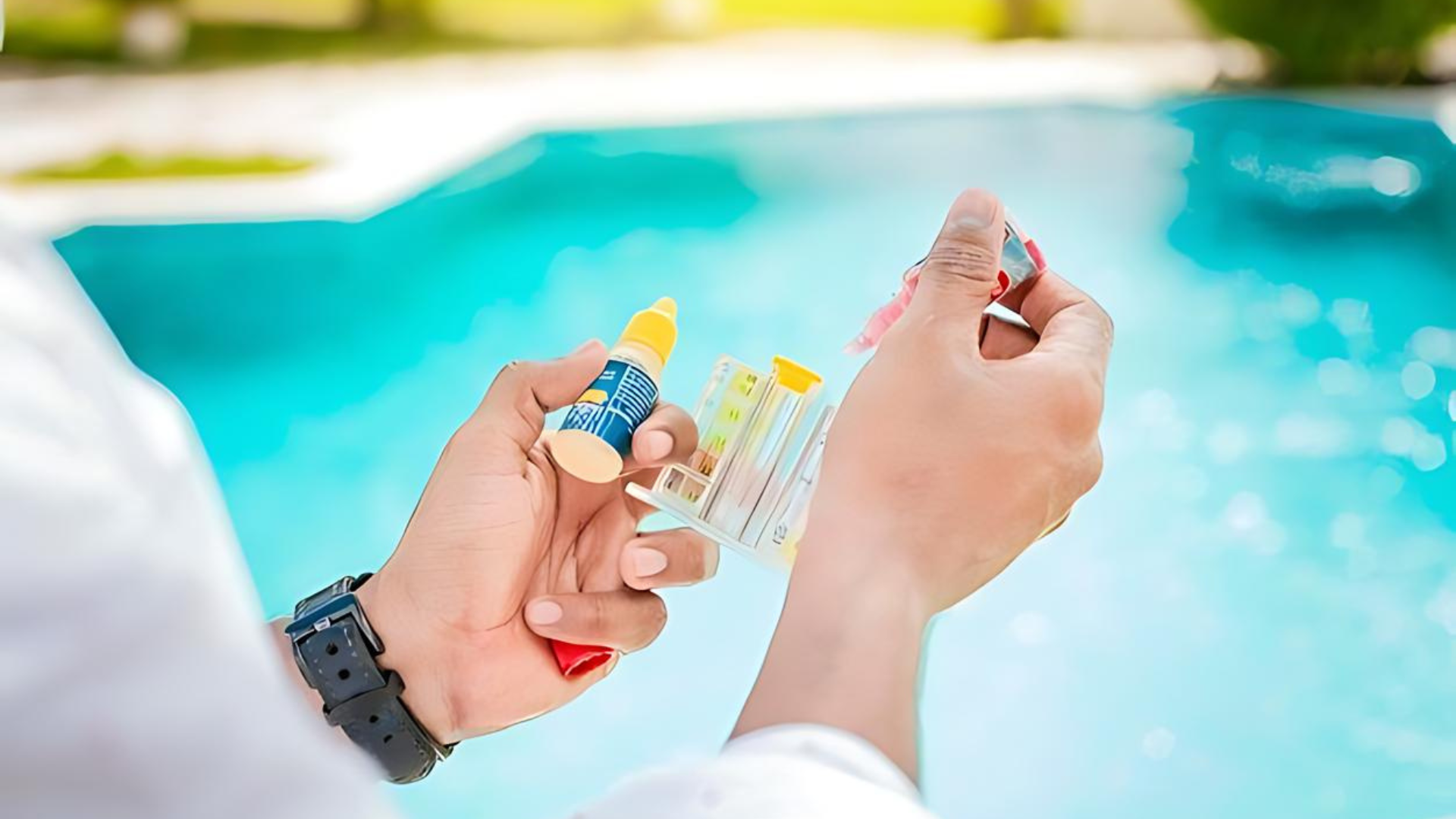
Understanding and maintaining proper water chemistry might seem complex at first, but mastering these basics will help you keep your pool in excellent conditions. Let's learn a little bit more about pool water chemistry:
pH Levels
pH is a measure of how acidic or basic your pool water is. A proper water balance ensures the pool is safe, comfortable, and the equipment lasts longer. If the range is too low (acidic) can cause eye and skin irritation, corrosion of pool equipment and if the range is too high (basic) can lead to cloudy water, scale formation, and reduced chlorine effectiveness. The ideal range of pH level in a pool is 7.2 to 7.6.
If you need to adjust pH use a pH increaser (soda ash) to raise pH or use a pH decreaser (muriatic acid or sodium bisulfate) to lower pH.
Chlorine Levels
Chlorine is your pool's primary sanitizer, killing harmful bacteria and preventing algae growth. The ideal range is 3 to 6 parts per million (ppm). If the range is too low it will have insufficient sanitation, potential for algae growth and if the range is too high, it can cause eye and skin irritation, bleaching of pool liner or swimwear.
To adjust chlorine, add chlorine tablets or liquid chlorine to increase levels or add a chlorine neutralizer to decrease levels. Remember that a stabilized chlorine (with cyanuric acid) lasts longer in outdoor pools exposed to sunlight.
Alkalinity
Total alkalinity acts as a buffer for pH, helping to prevent rapid pH fluctuations. The ideal range is 80 to 120 ppm. If the range is too low can cause pH to fluctuate wildly, leading to corrosion and staining. If the range is too high it can cause scaling and cloudy water. To adjust alkalinity use an alkalinity increaser (sodium bicarbonate) to raise levels and use pH decreaser to lower levels (this will also lower pH, so monitor closely).
Calcium Hardness
Calcium hardness measures the amount of dissolved calcium in your water. Proper levels prevent scaling or corrosion. The ideal range is 200 to 400 ppm. If the range is too low can lead to corrosion of pool surfaces and equipment and if the range is too high can cause scaling and cloudy water. add calcium chloride to increase levels and partially drain and refill the pool with softer water to decrease levels.
Our recommendation: These four factors work together to create a balance, so always test all parameters when making adjustments.
Testing Your Water
Invest in a reliable testing kit. Test strips are convenient for quick checks, but a liquid test kit often provides more accurate results. For the most precise analysis, consider taking a water sample to your local pool store for professional testing, especially at the beginning and end of the swimming season.
Common Pool Problems and Solutions
Algae Growth
Symptoms:
- Green, yellow, or black spots on pool walls
- Slippery surfaces
- Cloudy or discolored water
Solutions:
- Brush the affected areas vigorously
- Test and balance water chemistry, especially pH and chlorine levels
- Shock the pool with a high dose of chlorine
- Run the filter 24/7 until the water clears
- Use an algaecide as a preventative measure
Prevention:
- Maintain proper chlorine levels
- Ensure adequate circulation by running your pump at least 8-12 hours daily
- Brush pool walls weekly
Cloudy Water
Symptoms:
- Hazy or milky appearance
- Inability to see the pool bottom clearly
Solutions:
- Test and balance water chemistry
- Shock the pool if necessary
- Clean or backwash the filter
- Use a pool clarifier to help coagulate tiny particles
- Run the filter continuously until water clears
Prevention:
- Maintain proper chemical balance
- Clean the filter regularly
- Shower before swimming to reduce contaminants
Stains and Scaling
Symptoms:
- Discolored spots on pool surfaces
- Rough, crusty buildup on tiles or equipment
Solutions for Stains:
- Identify the type of stain (organic, metal, or mineral)
- Use appropriate stain removers (chlorine for organic, ascorbic acid for metal)
- Brush the stained area and maintain proper water balance
Solutions for Scaling:
- Test and lower calcium hardness if necessary
- Use a scale inhibitor product
- Manually remove scale with a pumice stone (be gentle to avoid surface damage)
Prevention:
- Maintain balanced water chemistry, especially pH and calcium hardness
- Address any metal equipment corrosion promptly
- Use an agent to prevent metals from causing stains
Pool Maintenance Tools and Equipment
Let's explore the essential equipment for DIY pool care and discover when to call a professional.
Telescopic Pole: This amazing tool is everything you need for your pool maintenance kit. It attaches to different accessories, allowing you to reach every corner of your pool.
Skimmer Net: This net attached to your telescopic pole will help you remove leaves, insects, and other debris from the water surface.
Pool Brush: You can use this brush to scrub walls, floor, and steps. Choose bristle strength based on your pool surface type.
Manual Vacuum Head and Hose: Used for thorough cleaning of the pool floor, can be attached to your telescopic pole.
Water Testing Kit: A water testing kit is crucial for monitoring your pool's chemical balance. Look for a kit that tests pH, chlorine, alkalinity, and calcium hardness.
Chemical Treatment Products: Stock up on chlorine, pH increasers and decreasers, alkalinity adjusters, and shock treatments.
Pool Cover: Helps keep debris out when the pool isn't in use, reducing cleaning time.
Leaf Rake: A deep net for removing larger amounts of debris, especially useful during fall.
Pool Filter Cleaner: Specific to your filter type (sand, DE, or cartridge).
Pool Thermometer: Useful to monitor water temperature for comfort and chemical effectiveness.
When to Call a Professional

While many pool maintenance tasks can be handled by homeowners, we leave you with some recommendations on when to call a professional:
- Opening and Closing the Pool: Professionals can ensure your pool is properly prepared for the season or winterized correctly.
- Equipment Installation or Repair: For issues with pumps, heaters, or filtration systems, it's best to consult an expert to avoid costly mistakes.
- Persistent Water Chemistry Issues: If you're struggling to balance your pool water, a pro can help identify and resolve the problem.
- Structural Repairs: Any cracks, leaks, or damage to the pool structure should be addressed by a professional.
- Electrical Problems: Never attempt to fix electrical issues yourself. This is a job for a professional in pool systems.
- Major Cleaning Jobs: For severe algae blooms or extremely dirty pools, professionals have the tools and expertise to get your pool back in shape quickly.
- Annual Inspections: Consider having a pro perform a thorough check-up at least once a year to catch any potential issues early.
- Resurfacing or Renovation: When it's time to update your pool's look or functionality, trust the experts to do the job right.
Reducing Maintenance Time and Costs
Let's explore some smart strategies to minimize your maintenance efforts and costs while keeping your pool in top shape:
Automatic Cleaners
Types of automatic cleaners:
- Suction-side cleaners: Connect to your skimmer or dedicated suction line
- Pressure-side cleaners: Use the pressure from your return line
- Robotic cleaners: Self-contained units with their own filtration system
Benefits:
- Continuously clean your pool, reducing manual vacuuming
- Can reach areas that are difficult to clean manually
- Some models can climb walls and clean steps
Pool Covers
Types of covers:
- Solar covers: Reduce evaporation and heat loss
- Safety covers: Provide protection against accidental entry
- Automatic covers: Offer convenience with the push of a button
Benefits:
- Reduce debris in the pool, cutting down on cleaning time
- Minimize chemical loss due to evaporation
- Can help heat the pool (solar covers) or maintain temperature
Efficient Filtration Systems
Key considerations:
- Ensure your filter and pump are correctly sized for your pool
- Variable-speed pumps can significantly reduce energy consumption
- Clean or backwash your filter as needed
Benefits:
- Improved water quality with less effort
- Lower energy bills
- Reduced need for chemicals
Our Recommendation: Running your pump at lower speeds for longer periods is often more efficient than short bursts at high speed.
Smart Pool Technology
- Automated chemical feeders maintain consistent chlorine levels
- Smart pool controllers allow you to monitor and adjust settings remotely
- UV or ozone systems can reduce chemical usage
Encourage good pool habits among swimmers, like shower before entering the pool to reduce contaminants, avoid entering with lotions or oils on the skin and remove debris they notice while swimming

Maintaining a crystal clear pool doesn't have to be a daunting task. By following the steps and tips outlined in this guide, you can keep your pool in top condition with minimal effort and expense.
Remember, the key to pool maintenance lies in consistency and prevention. Daily, weekly, and monthly tasks, combined with proper seasonal care, will help you avoid major issues down the line. Understanding the basics of water chemistry and promptly addressing common problems will ensure your pool remains safe, clean and inviting.
Dive in, stay cool, and enjoy your crystal-clear pool all summer long!



